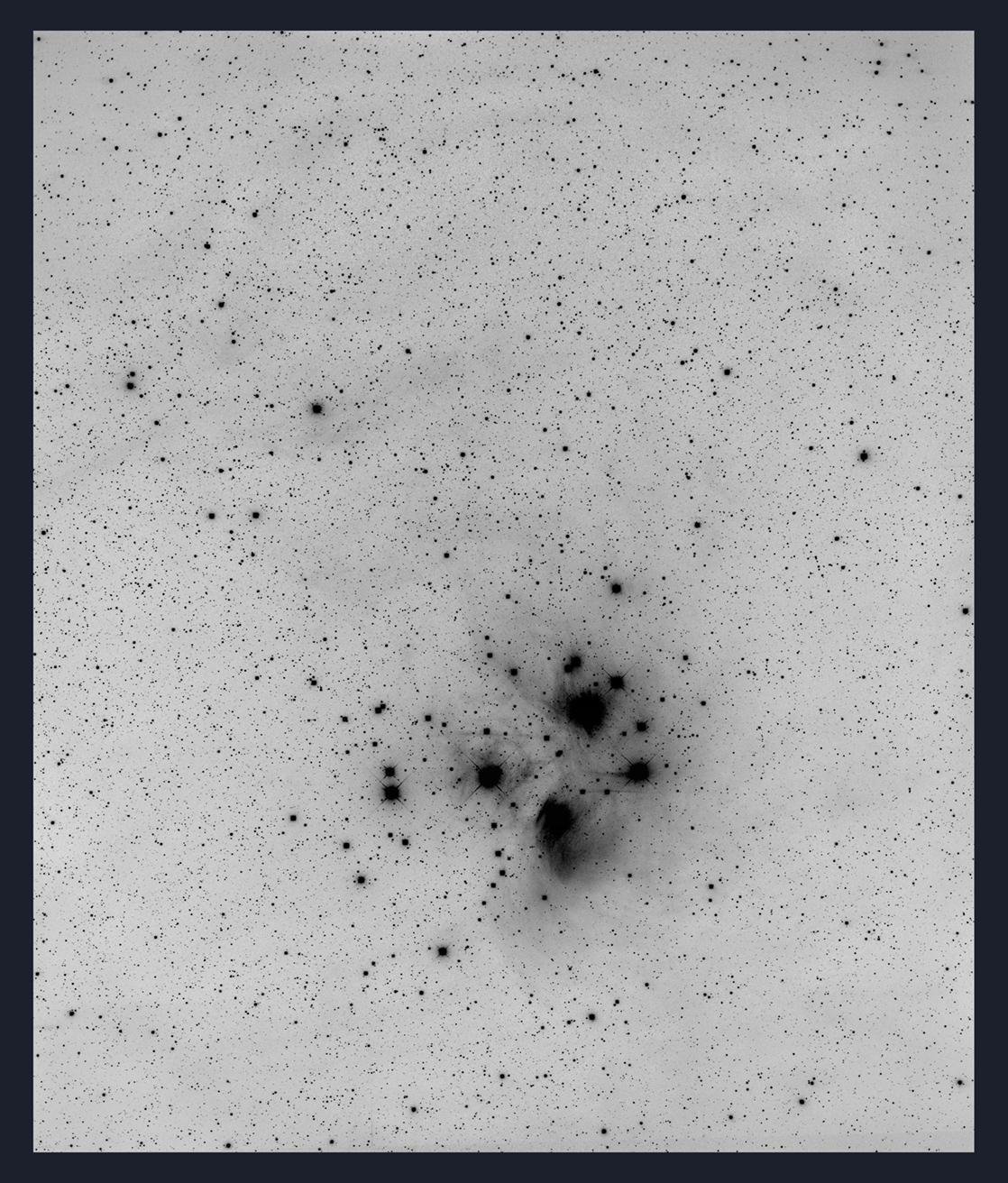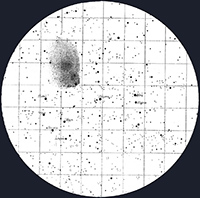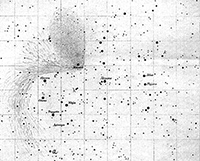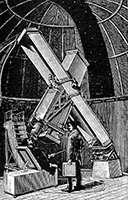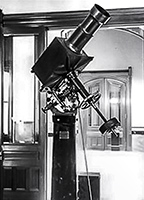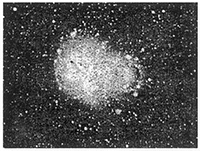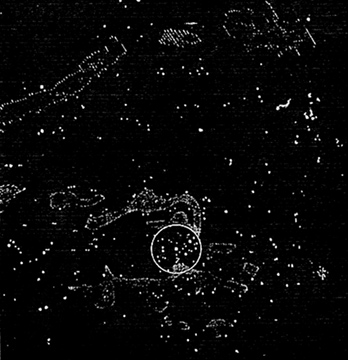 |
| Al di la della Luna; Beyond the Moon; Astrophotography; Astrofotografia; Danilo Pivato |
 |
||||||||
Photo: Danilo Pivato © Copyright: - Images & texts 2018 - All rights reserved |
||||||||
The Analysis of Frame |
||||||||
M 45/Pleiades Region - Open (galactic) Cluster: In Taurus - Cr 42; Seven Sister; Cl Melotte 22; Ocl 421.0; Lund 117; C0 344+239; H 0346+24; Open (galactic) Cluster - Field: 12,7° x 15,7° - Mag. Limite Image: --.-^ - --.-^ (r) - Fonte: - Object Coordinates: RAJ2000.0 03h 47m 00.0s - Dec J2000.0 +24° 07' 00.0" [SIMBAD] - Magnitudine: --.-^ (b); --.-^ (v), --,-^ (r); Surface Brightness: --.-^ - Object Size: 120,0' x 120,0' [SIMBAD] - Position Angle: ---° - Object Classification: l3rn.- Redshift z(~) V (Km/s): 3.503 - Spectrum: --- Distance: 425 ly |
||||||||
L'ammasso aperto delle Pleiadi, il soggetto principale che occupa il centro dell'inquadratura, appartiene a quella categoria di oggetti noti sin dall'antichità. Dell'ammasso stellare infatti sono almeno 6-7 le stelle visibili ad occhio nudo che diventano 9 con moderate condizioni di visibilità, e salgono addirittura 12 sotto cieli bui e trasparenti. Secondo Kenneth Glyn Jones, il primo riferimento conosciuto all'ammasso è una citazione di Esìodo, risalente circa al 1.000 a.C.. Omero ne fa menzione nell'Odissea e nella Bibbia, nel Vecchio Testamento, compaiono almeno tre riferimenti alle Pleiadi. Sono chiamate anche: Le Sette Sorelle, e le implicazioni mitologiche sono presenti nelle leggende di tutti i popoli della Terra. Nell'antico Giappone furono chiamate "Subaru", oggi utilizzato per l'omonimo marchio automobilistico, o per il nome del più grande telescopio giapponese realizzato sul Mauna Kea, nelle Hawaii. Le antiche denominazioni del Nord europa invece (per esempio quelle inglesi, tedesche e vichinghe) ci dicono che un tempo erano paragonate ad una "Chioccia con i pulcini". Robert Burnham Jr. fa riferimento sia alla possibile origine del nome "Pleiadi" dalla parola greca "plein" che indica il "navigare", e sia alla parola "pleios" che significa "abbondanza" o "moltitudine". Seguendo la mitologia greca, le stelle principali hanno il nome delle sette figlie di Atlante e di Pleione: Alcione (h Tau - 2.9^ mag.), Asterope (21 Tau una stella doppia - 5.8^ mag.), Elettra (17 Tau - 3.7^ mag.), Maia (20 Tau - 3.9^ mag.), Merope (23 Tau - 4.2^ mag.), Taygeta (19 Tau - 4.3^ mag.) e Celaeno (16 Tau - 5.^5 mag.). La poetessa greca Saffo (630-570 a. C.) scrive: "...tramontata è la Luna e tramontate sono le Pleiadi, la notte è a metà del suo corso..."). Anche in letteratura latina esistono brani in cui ci sono riferimenti alle Pleiadi: Publio Virgilio Marone nelle sue Georgiche scrive con queste parole: "... Due volte le arnie si riempiono di miele quando la Plejade Taigete, innalzando la sua fronte verginale sopra l'orizzonte, respinge con sdegnoso piede i flutti dell'oceano, e quando, sfuggendo agli sguardi dei piovosi pesci, si rituffa tristamente in seno all'onda gelata..."; così come in quella araba, cinese, egiziana, indiana, esistono citazioni con le Pleiades. Tutte le 7 stelle dell'ammasso delle Pleiadi sono al di sopra della soglia della sesta magnitudine, quindi vista la loro grande visibilità in cielo hanno goduto nei millenni passati del privilegio di essere state un riferimento importante in molte culture. L'ammasso M 45 dista 430 anni luce ed è tra i gruppi stellari più vicini; stando a recenti studi sembra contenere almeno 1000 stelle, la maggior parte delle quali risultano deboli, che si estendono per oltre 2°, presentando quindi una densità, se confrontata con gli altri ammassi galattici, relativamente bassa. La classificazione di Trumpler per le Pleiadi è tipo: II,3,r (di Trumpler, secondo Kenneth Glyn Jones) o I,3,r,n (Götz e Sky Catalog 2000), ciò significa che questo ammasso appare isolato, fortemente o moderatamente concentrato verso il centro; le sue stelle presentano un'ampia gamma di luminosità ed è come visto in precedenza, numericamente ricco. La maggior parte delle stelle più luminose delle Pleiadi sono di tipo spettrale Be, stelle blu quindi, calde e giovani, mentre l'ammasso contiene anche numerose nane brune e deboli stelle "flares" di cui alcune di quest'ultima categoria furono scoperte dall'astronomo italiano Loenida Rosino (L. Pigatto, L. & Rosino - "Flare stars in the Pleiades region" Memorie della Società Astronomia Italiana, Vol. 43, p.455). La loro luminosità varia nell'arco di pochi minuti o ore e possono aumentare anche di 4 magnitudini; generalmente sono comprese tra la +13^ e la +17^ magnitudine. Nella presentazione delle immagini a scala maggiore di prossima pubblicazione si individueranno sulle corrispettive mappe queste stelle di tipo "Flare" presenti nelle Pleiadi. |
||||||||
| La fotografia - L'area ritratta in questa fotografia a colori su emulsione chimica è stata eseguita l'11 dicembre 2004 (dia n.2505) a Forca Canapine (PG) dal piazzale del rifugio Monti del Sole. Al centro è posto l'ammasso galattico delle Pleiadi. Pur essendo una fotografia realizzata su pellicola Kodak E200 nel formato 60x70mm tramite una singola esposizione di 43 minuti (i dati tecnici dello scatto sono riportati in calce al positivo), pone in evidenza la grande estensione delle nebulosità annesse all'ammasso galattico, in particolare la regione a SW delle Pleiadi che si estende per quasi 3°- 4° mostrando le propaggini della ancor più debole IC 341. Impercettibili al limite del fodo cielo, è possibile individuare anche alcune tracce delle deboli nebulose ad emissione rossastre e a riflessione di fondo che riempiono totalmente il campo (IC 353; IC1995; LBN 779, LBN 777, LBN 774 ecc.). Come anticipato altrove, è questa una fotografia già pubblicata nel 2006 all'interno del Forum di Astrofili.org [precisamente: qui], con la differenza che in quest'ultima immagine è stata approntata una nuova e recente elaborazione, perchè in quel periodo tendevo a proporre immagini con dominante blu. Purtroppo è affetta da un poco di rotazione di campo, in particolare nella parte superiore in prossimità degli angoli. Approfittando di questo risultato e degli altri a seguire, si è anche fatta una modesta ricerca su notizie, mezzi ed eventi storici che hanno caratterizzato le scoperte degli oggetti deep-sky appartenenti a quest'area del cielo, legate a personaggi importanti con vicissitudini, curiosità affascinanti e poco conosciute, ma tipiche dell'epopea d'oro dell'astronomia accademica di inizio-fine '800. |
||||||||
The Pleiades Nebulae e le grandi polemiche di fine '800 - L'ammasso stellare delle Pleiades nonostate sia conosciuto fin dall'antichità e nonostante appartenga al celebre catalogo di Messier, non ha un corrispettivo numero di catalogo in quello del New General Catalogue (NGC) di John Louis Emil Dreyer; tuttavia i suoi dintorni sono caratterizzati da molte deboli nebulose e soltanto alcune di queste rientrano nel catalogo del Dreyer. La luce di queste nebulose è apparentemente luce stellare riflessa da polvere cosmica sparsa ovunque con diverse concentrazioni e forse da particelle solide più grandi. Verso la fine degli d'oro delle osservazioni visuali e poco prima che la fotografia chimica entrò a pieno regime nell'ambito dell'astronomia professionale, tutte le osservazioni sulle nebulosità percepite dell'ammasso aperto delle Pleiadi furono oggetto di continue contese e dispute tra gli astronomi di fine '800 |
||||||||
|
||||||||
|
||||||||
|
||||||||
|
||||||||
|
||||||||
Successivamente Dreyer inserì le nebulose indicate da Barnard nella prima edizione dell'Index Catalogue con le sigle: IC 336, distante 1,6° a SO delle Pleiades; IC 341, 2,5° a SO dell'ammasso M45; IC 353, 1,5° a NE delle Pleiades; IC 354, a 2° ESE delle Pleiades; e infine IC 360, distante 6,2° in direzione ENE dalle Pleiades (vedere la mappa in CAD), tutte attribuiti a Barnard. Sempre a riguardo di questa regione del cielo a gennaio del 1895, Max Wolf scrisse delle scoperte di E. E. Barnard in suo articolo su "Notiz uber die Plejaden-Nebel" e che anche lui disse che aveva già fotografato, riportandone i risultati sulla rivista Sirius (Max Wolf 1891), quella stesse nebulose. Egli sottolineava poi una caratteristica interessante riguardo a queste deboli nebulose che emergevano sulle sue lastre fotografiche dopo un'esposizione ben più lunga rispetto a quanto ottenuto da E.E. Barnard. Nel 1895 Agnes Mary Clerk descrive anch'essa le scoperte di Barnard sul numero di dicembre della rivista: Knowledge dove fra l'altro viene riprodotto un interessante disegno di Barnard del 1893 (sopra a destra). La Clerk riporta anche che tra le Pleiadi e la Via Lattea autunnale si trova una delle 52 Regioni segnate dal grande William Herschel composte da "... vaste nebulosità diffuse", risalenti al 1811, indicando, sembra, l'oggetto numero 13 come: " much affected"! Purtroppo per Herschel, egli non fu mai preso in seria considerazione dai suoi colleghi sulla rilevazione di queste 52 aree. E.E. Barnard cita una lettera di Herbert Cooper Wilson del Goodsell Observatory - Northfield - Minnesota del 26 giugno 1895, in cui il Wilson ottenne una fotografia con una esposizione di 11 ore (!) eseguita sulla regione circostante le Pleiades nelle notti del 23, 24 e 26 ottobre del 1894 la quale mostra la maggior parte delle nebulose che Barnard stesso disegnò nel 1894. E' la volta poi del giovane astronomo russo Vsevolod Stratonov di Odessa, l'attuale Ucraina, il quale nel maggio del 1895 tramite l'astrografo Repsold/Henry da 33cm dell'Osservatorio di Tashkent, scopriva la nebulosa esterna alle Pleiades (...Continua) |
||||||||
| IC 353 - Galactic Nebula: in Taurus - Ced 24; LBN 774; Object Coordinates: RAJ2000.0 03h 55m 30.0s - Dec J2000.0 +25° 29' 00.0" [Uranomria 2000.0] - Magnitudine: --.-^ (b); --.-^ (v), --,-^ (r); Surface Brightness: --.-^ - Object Size: 180,0' x 30,0' [Uranometria 2000.0] - Position Angle: ---° - Object Classification: ---.- Redshift z(~) V (Km/s): ----.- Spectrum: --- Distance: --- ly | ||||||||
Nebulosa a riflessione che Dreyer, nel suo Index Catalogue, riporta come: "molto debole, estremamente grande e molto diffusa". E' una vasta nebulosa a riflessione che si trova a NE delle Pleiades con il quale è probabilmente collegata fisicamente. Il suo diametro è circa di 3°. Per lo storico H. G. Jr Corwin, questa è una delle numerose nebulose a riflessione attribuite a Barnard presenti in questa regione, tra cui, come si è visto più sopra, ci sono anche IC 336, IC 341, IC 354 e IC 360. Dal punto di vista storico però non sono, tutt'ora oggi, chiari alcuni punti. Sebbene Barnard abbia eseguito un disegno che mostri le nebulose, risulta che è stato Dreyer a scegliere quali aggiungere nel catalogo. Infatti alcuni degli oggetti IC corrispondono ai segni presenti sul disegno-bozza di Barnard, ma altri no, quindi è difficile comprendere le scelte del Dreyer. Sembra sia stata fatta confusione. Nella maggior parte degli atlanti cartacei che ne indicano la presenza tra cui: Atlas Coeli 1950.0; Sky Atlas; Uranometria 2000.0; Millennium Star Atlas; TriAtlas; The Cambridge Photographic Star Atlas, per citarne alcuni, riportano la posizione di questa nebulosa diffusa a riflessione a circa 2° NE dell'ammasso delle Pleiadi. Dal database [SIMBAD], fonte autoritaria del CDS di Strasburgo, fino a non molti giorni or sono (novembre 2017) era in difetto di ben 7° in declinazione. Grazie ad una mia segnalazione è stata effettuata la correzione. |
||||||||
| [da completare] | ||||||||
| History of Observation and description: | ||||||||
| Known pre-historically. Mentioned by Homer about 750 B.C. and by Hesiod about 700 B.C. | ||||||||
| Charles Messier: March 4, 1769. 45. 3h 33m 48s (53d 27' 04") +23d 22' 41" A cluster of stars, known by the name of the Pleiades. The position reported is that of the star Alcyone. [Mem. Acad. for 1771, p. 451-452 (first Messier catalog)] [Messier reports to have measured the stars of the Pleiades in 1785, 1790, and 1796.] |
||||||||
Giovanni Battista Hodierna: Ha. I.1: [1654] [1.] The first, and the most lumious of all assemblies of stars, shines in the belly of Taurus; six, or seven stars are most evident, before many others, .. [counted 37 stars] |
||||||||
| Johan Elert Bode: Bode 8.: A wellknown cluster of small stars. [Position of Alcyone in the Pleiades in Taurus] |
||||||||
Johan Elert Bode: (1782: [From: Vorstellung der Gestirne auf XXXIV Kupfertafeln (Introduction to the Stars on 34 Copper Plates), 1782.]
[Ch. 14, p. 17] No. 15 to 28 are the stars of the Pleiades. [p. 18] The Pleiades are represented on the 14th plate at the right, by the 28 stars of Flamsteed, T. Mayer & le Monnier. On the 1st figure of the 30th plate, there are also the stars from 203 to 242, with diverse others which have been observed by the Abbé Outhier; these are those which I have increased the Pleiades to a number of 120 stars. [Plate XXX, p. 38] g. Celano. c. Maia. f. Atlas. b. Electra. d. Merope. h. Pleione. e. Taygeta. h. Alcyone. k. & l. Asterope 1. and 2.
|
||||||||
William Henry Smyth: CXLII (142). Eta Tauri: [Smyth has separate entries for 4 individual stars in the Pleiades, but describes the cluster under the star h Tauri. The four separate entries are CXXXVIII. 19 Pleiadum (Taygeta), CXXXIX. 15 Pleiadum (of mag 8), CXL. 23 Pleiadum (Merope), and CXLIV. 27 Pleiadum (Atlas)]
CXLII. h Tauri. AR 3h 37m 59s, Dec N 23d 36'.3 Mean Epoch of Observation: 1836.97 [Dec 1836] Alcyone, a Greenwich star, with a distant companion, in the midst of the Pleiades, called by the Arabians Jauza, the wall-nut, and Neyyir, bright, or lucida [the brightest] of the Pleiades. A 3 [mag], greenish yellow; B 7, pale white. Piazzi marked this "duplex," but the comes could only be 151 P. III.; and a reduction from his mean apparent places, and the micrometrical measures of Sir John South, afford these results: P. Pos. 288d 00' Dist. 122".50 Ep. 1800 S. 288d 42' 116".40 1824which, considering that A is chargeable with a small proper motion both in AR abd declination, is very consistent with more recent observations. The other two small stars in the same, or np [north preceding, NW] quadrant, form the "binae ad boream" mentioned in 150 P. III; and were also measured by S. The proper motions alluded to, are thus valued: P. .... AR -0".04 Dec -0".09 S. .... +0".06 -0".05This star has usually been considered as the one described under the 32nd of Taurus, in Ptolemy, and there marked Epsilon in brightness. But Mr. Baily says, "I don't think this star can be Eta Tauri, on account of its magnitude: yet it is singular that the brightest star in the pleiades should not have been noticed by Ptolemy (*)." The occultation of this star, and h Pleiadum, by the dark limb of the Moon, were well observed on the 19th March, 1839, by my [Smyth's] excellent friend Lord Chief Justice Tindal; who thus elegantly occupied the evening of a tedious assize-day at Bedford. The observations were made with the 8 1/2-foot equatorial, charged with an eye-piece magnifying ninety-three times.
The Pleiades constitute a celebrated group of stars, or miniature constellation, on the shoulders of Taurus; their popular influences have been said and sung for many years. Hesiod mentions them as the Seven Virgins, "of Atlas born;" and in the ancient M.S. of Cicero's Aratus, in the British Museum, they are finely represented by female heads, inscribed Merope, Alcyone, Celaeno, Electra, Taygeta, Asterope, and Maia, under the general title Atlantides, - while the illustrations to Julius Firmicius in 1497, represents them as well-grown women. The moral may be, that Atlas himself first rigidly observed these stars, and named them after his daughters.But various are the appellations under which they have been known. THeon liked them to a bunch of grapes; Aratos says they were called Eptaporoi; Manilius clusters them as glomerabile sidus; the Arabs said they were Ath-thurayya, or the little ones; the French designate them as poussinière; the Germans, gluckhenne, the Italians knew them as le gallinelle; the Spaniards term them the cabrillas, or little manny-goats, which is the key of the Duke's query to sancho; and several schools called them brood-hen, under the representation of a hen with chickens. There has also been much discussion as to the number of the individuals in the group, some of the ancients having advanced that there were seven, and others resolving to count six, in the spirit of Ovid's oft-cited Quae septem dici, sex tamen esse solent. The "lost Pleiad" is however, rather a poetical than an exact expression, for in moonless nights I never had any difficulty in counting seven stars in the so-called Hexastron, with the naked eye; and indeed this is nothing to boast of, for many people may enumerate even more, though few will equal with Maestlinus, the discoverer of the new star of 1604, who, as Kepler avers, could distinctly see fourteen stars in the Pleiades, without any glasses. Still, if we admit the influence of variability at long periods, the seven in number may have occasionally been more distinct; so that while Homer and Attalus speak of six of them, Hipparchus and Aratus may properly mention seven. But they have a singular brilliant light for their magnitudes, whence the unassisted eye becomes dazzled. The ancients allotted to them only seven stars; but in modern catalogues, their numbers have run thus: Kepler . . . . 32 stars Hook . . . . . 78 stars Galileo . . . . 36 Jeaurat . . . . 103 De la Hire . . . 64 F. de Rheita . . 188 And the zealous amateur may be assured, that there are yet many recruits for him who will undertake an exact chart of them, the which is still a desideratum, the cluster being directly in the Moon's path, and therefore the site of abundance of occultations. This part formerly constituted the Third Lunar Mansion; and is so generally known, that is, alineation need hardly be pointed out; yet it may be added, that an imaginary line through the wain of the Great Bear, passing Capella, leads to the Pleiades; or, from the southwest, a line from Sirius, carried over Orion's belt, meets them. |
||||||||
John Frederick William Herschel:, General Catalogue: The Pleiades are not in the GC catalog, however, the first discovered nebula around Merope is:
|
||||||||
John Louis Emil Dreyer: The Pleiades are not in the NGC or IC catalog, however some of the nebulosities within them are:
|
||||||||
Francis Bailey: Pleiades ... RA 03:41. , Dec +23:48 (1900.), Diam 120'; class D3 [Coarse, irregular, stars of different magnitudes (cluster)], B1 [Large, diffused, irregular (nebula)] ! Cluster, well known cluster of bright stars, not given in the N.G.C. Remarks: Pleiades. The number of stars which really belong to this cluster is doubtful. Several thousand stars have been photographed in this region, but there is no proof that many of these belong to the cluster, since even this large number is no greater, if, indeed, it is as great, as that in an equal area of the surrounding regions. Apparently the cluster itself consists of a few bright stars. Plate I, Figure 1. The Pleiades. The original photograph shows faintly and brighter nebulosities, but a much longer exposure is needed with the Bruce telescope to show them to good advantage. See Mem. Acad. Amer. Acad. 11, 224. The area shown in this, and in each of the following three figures is a triffle more than two square degrees. |
||||||||
Heber Doust Curtis: [Descriptions of 762 Nebulae and Clusters photographed with the Crossley Reflector. Publ. Lick Obs., No. 13, Part I, p. 9-42] RA= 3:41 , Dec=+24:.. The Pleiades. L.O. Publ., Vol. VIII, Plate 8. 0 s.n. |
||||||||
| Camille Flammarion: in [Les Etoiles et les curiosites du ciel - 1904] dedica numerose pagine sul conteggio e visibilità delle stelle sotto diversi occhi con particolarissime digressioni storiche. | ||||||||
Bibliografia di riferimento: Simbad: Astronomical Database - CDS (Strasbourg) NED: NASA/IPAC Extragalactic Database VizieR: published astronomical catalogues and data tables Historical Deep Sky Object List: by H. Frommert; C. Kronberg; Glen Cozens; G. McArthur; B. Arnett Aladin: Sky Atlas - Centre de Données astronomiques de Strasbourg (CDS) Guide software: Project Pluto 168 Ridge Road Bowdoinham ME 04008 (UNITED STATES) Burnham's Celestial Handbook: An Observer's Guide to the Universe Beyond the Solar System - Robert Burnham, Jr - Dover Pubblications. Inc - Ney York NGC 2000.0 - Roger W. Sinnott - Sky Publishing Corporation - Cambridge, Massachusetts Star Clusters - B. A. Archinal, S. J. Hynes - Willmann-Bell, Inc. Il cielo - G. Cecchini - Unione Tipografico - Editrice Torinese NGC - IC Photographic Catalogue - Shigemi Numazawa & Nanayo Wakiva - ed. Seibundo Shinkosha University Publishing co. Ltd. - 2009 The Revised New General Catalogue of NonStellar Astronomical Objects - J.W. Sulentic & W. G. Tifft - The University of Arizona Press Tucson, Arizona Sky Catalog 2000.0 - Vol. 2 - Double Stars and Nonstellar Objects - edited by A. Hirhfeld & R. W. Sinnott - Sky Publishing Corporation - Cambridge, Massachusetts Atlas of the Messier Objects - R. Stoyan, S. Binnewies, S. Friedrich & K. P. Schroeder - Cambridge, University Press 70 Photometry of The stars in Galactic Cluster Fields - Pubblications of the United States Naval Observatory XVII 1950-61 Catalogue Interstellarum Deep sky Atlas - R. Stoyan, S. Schuring - Oculum Cambridge University Press 2014 Millennum star Atlas - R. W. Sinnott, M. A. C. Perryman - Sky Publishing Corporation - Cambridge, Massachusetts - ESO - ESTEC, Noordwijk, The Netherlands Atlas of The Heavens - Atlas Coeli 1950.0 - Antonin Becvar - Sky Publishing Corporation - Cambridge, Massachusetts - Czechoslavak Academy of Sciences TriAtlas Second Edition - J. R. Torres & C. Skelton Observing & Cataloguin Nebulae & Star Clusters - W. Steinicke - Cambridge University Press - 2011 ACompanion to Astronomy & Astrophysics - K. R. Lang - Springer Astronomical Observations - E. Gregersen - Britannica Educational Publishing Astronomie Populaire Description Genelrale du Ciel - Camille Flammarion - Paris C. Marpon et E. Flammarion Editeurs - 1880 Atlas & Catalog of Dark Clouds Based on Digitized Sky Survey I - K. Dobashi, H. Uehara, R. Kamdori, T. Sakurai & M. Kaiden - Astrophysical Journal Biographical Encyclopedia of Astronomers - K. Bracher, R. J. Jarrell, J. D. Marché, E. J. Ragep - Springer Catchers of the Light - Vol. 1 - Stephan Hughes -
|
||||||||
Danilo Pivato © Copyright: - Images & texts 2017 - All rights reserved |
||||||||
